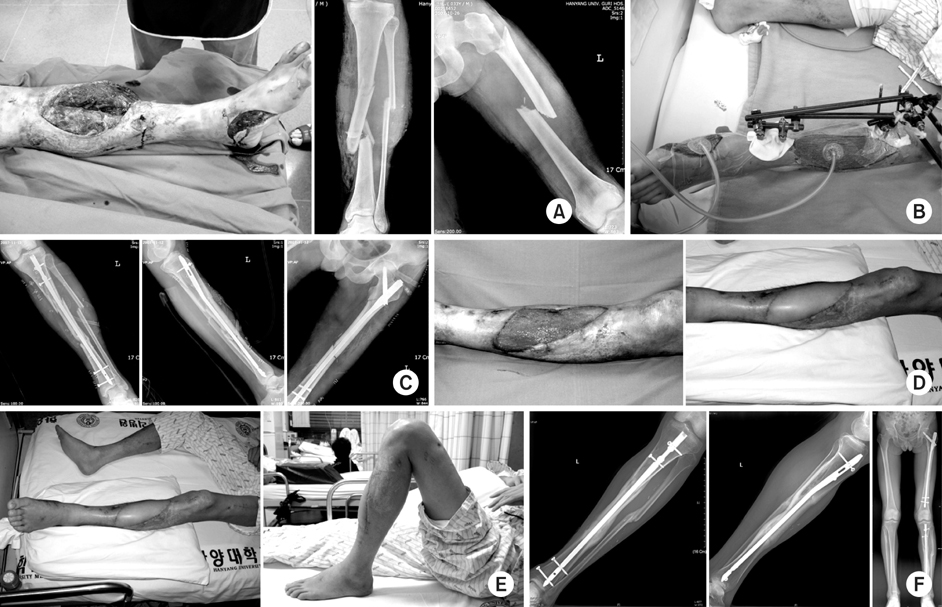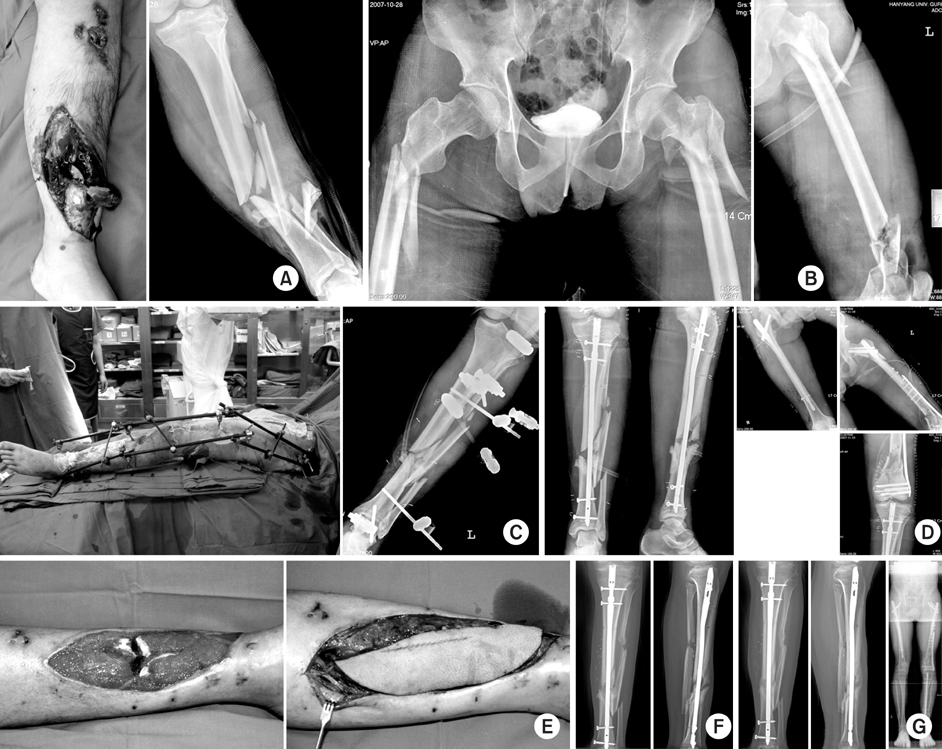J Korean Fract Soc.
2010 Jan;23(1):155-159. 10.12671/jkfs.2010.23.1.155.
Acute Management of Soft Tissue Defect in Open Fracture
- Affiliations
-
- 1Department of Orthopaedic Surgery, Guri Hospital, Hanyang University College of Medicine, 249-1, Gyomoon-dong, Guri 471-701, Korea. kcpark@hanyang.ac.kr
- KMID: 1461586
- DOI: http://doi.org/10.12671/jkfs.2010.23.1.155
Abstract
- No abstract available.
MeSH Terms
Figure
Cited by 2 articles
-
Management of Open Fracture
Gu-Hee Jung
J Korean Fract Soc. 2010;23(2):236-250. doi: 10.12671/jkfs.2010.23.2.236.Treatment of Type IIIb Open Tibial Fractures
Seong Yeon Lim, Il Jae Lee, Jae Ho Joe, Hyung Keun Song
J Korean Fract Soc. 2014;27(4):267-273. doi: 10.12671/jkfs.2014.27.4.267.
Reference
-
1. Anglen JO. Wound irrigation in musculoskeletal injury. J Am Acad Orthop Surg. 2001. 9:219–226.
Article2. Anglen JO, Apostoles S, Christensen G, Gainer B. The efficacy of various irrigation solution in removing slime-producing staphylococcus. J Orthop Trauma. 1994. 8:390–395.3. Argenta LC, Morykwas MJ. Vacuum-assisted closure: a new method for wound control and treatment: clinical experience. Ann Plast Surg. 1997. 38:563–576.4. Beardmore AA, Brooks DE, Wenke JC, Thomas DB. Effectiveness of local antibiotic delivery with an osteoinductive and osteoconductive bone-graft substitute. J Bone Joint Surg Am. 2005. 87:107–112.
Article5. Dedmond BT, Kortesis B, Punger K, et al. The use of negative-pressure wound therapy in temporary treatment of soft tissue injuries associated with high energy open tibial shaft fractures. J Orthop Trauma. 2007. 21:11–17.
Article6. Godina M. Early microsurgical reconstruction of complex trauma of the extremities. Plast Reconstr Surg. 1986. 78:285–292.
Article7. Gopal S, Majumder S, Batchelor AG, Knight SL, De Boer P, Smith RM. Fix and flap: the radial orthopsecid and plastic treatment of severe open fractures of the tibia. J Bone Joint Surg Br. 2000. 82:959–966.8. Henry SL, Ostermann PA, Seligson D. The antibiotic bead pouch technique, the management of severe compound fractures. Clin Orthop Relat Res. 1993. 295:54–62.9. Joseph E, Hamori CA, Bergman S, Roaf E, Swann NF, Anastasi GW. A prospective randomized trial of vacuum-assisted closure versus standard therapy of chronic non-healing wounds. Wounds. 2000. 12:60–67.10. Lee KB, Choi J, Moon ES, Yoon TR, Lim KY. Negative pressure wound therapy for traumatic soft tissue defects. J Korean Fract Soc. 2006. 19:67–71.
Article11. Lionelli GT, Lawrence WT. Wound dressings. Surg Clin North Am. 2003. 83:617–638.
Article12. McKee MD, Wild LM, Schemitsch EH, Waddell JP. The Use of an antibiotic-impregnated, osteoconductive, bioabsorbable bone substitute in the treatment of infected long bone defects: early results of a prospective trial. J Orthop Trauma. 2002. 16:622–627.
Article13. Morykwas MJ, Argenta LC, Shelton-Brown EI, McGuirt W. Vacuum-assisted closure: a new method for wound control and treatment: animal studies and basic foundation. Ann Plast Surg. 1997. 38:553–562.14. Patzakis MJ, Bains RS, Lee J, et al. Prospective, randomized, double-blind study comparing sigle-agent antibiotic therapy, ciprofloxacin, to combination antibiotic therapy in open fracture wounds. J Orthop Trauma. 2000. 14:529–533.
Article15. Steiert AE, Gohritz A, Schreiber TC, Krettek C, Vogt PM. Delayed flap coverage of open extremity fractures after previous vacuum assisted closure therapy-worse or worth? J Plast Reconstr Aesthet Surg. 2009. 62:675–683.
Article16. Webb LX. New techniques in wound management: vacuumassisted wound closure. J Am Acad Orthop Surg. 2002. 10:303–311.
Article17. Zalavras CG, Patzakis MJ, Holtom P. Local antibiotic therapy in the treatment of open fractures and osteomyelitis. Clin Orthop Relat Res. 2004. 427:86–93.
Article
- Full Text Links
- Actions
-
Cited
- CITED
-
- Close
- Share
- Similar articles
-
- Acute Shortening and Gradual Lengthening for a Comminuted Tibia Fracture with Massive Bone and Soft Tissue Defect: Case Report
- Reconstruction of a Traumatic Soft Tissue Defect
- Reversed Adipofascial Flap for Hindfoot Soft Tissue Defect combined with Open Calcaneal Fracture: A Case Report
- Comparison of Treating Tibial Nonunion with Bone and Soft Tissue Defect: Ilizarov Only Versus Free Flap and Ilizarov
- The Treatment of Infected Fracture of Long Bones




